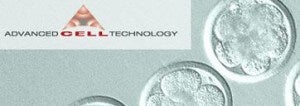
Massachusetts based biotech company Advanced Cell Technology recently announced that the FDA has granted orphan drug status to MA09-hRPE – an embryonic stem cell derived treatment for a specific form of blindness (Stargardt’s Macular Dystrophy). Orphan drug status is targeted to those therapies which are designed to treat fewer than 200,000 Americans and gives ACT access to tax credits, grants for clinical trials, and a seven year exclusivity to market MA09-hRPE. This is the first such FDA approval for an embryonic stem cell derived therapy and ACT plans on using the orphan drug status to accelerate clinical testing. While Advanced Cell Technology has something of a checkered past, this recent FDA status could signal not only an approaching success for the MA09-hRPE treatment, but also a promising advancement in the company’s goal to pioneer new forms of regenerative medicine.
Up to now the only real US embryonic stem cell derived treatment fit to discuss was Geron’s therapy for spinal cord injury which has been stalled off and on in clinical trials. As such, ACT is joining a very exclusive club, albeit for a disease that has a fairly narrow base of patients. US research into embryonic stem cell technologies was stunted after the Bush administration restricted federal funding. Now, Geron and ACT may represent a new page in that research – a growing trend of the US recovering for lost time and developing new stem cell technology. As we’ve seen with the increase in US medical tourism, Americans (and many others around the world) are anxious to get their hands on stem cell treatments.
ACT’s development of MA09-hRPE could help restore the vision of thousands. Macular dystrophy affects millions in the US and around the world. Stargardt’s (SMD) affects many fewer (less than 50k in the US), but can still lead to permanent blindness by destroying the retinal pigment epithelium (RPE). ACT has shown success in rodent tests by introducing the embryonic stem cell derived RPE cells into the eye. According to the ACT press release, this resulted in 100% improvement with no side effects, and with the RPE cells lasting for more than 220 days. Those are remarkable and very promising results.
However, ACT’s scientific claims are still tainted by some mistakes made earlier in the century. Under former CEO Michael West, ACT announced a series of results that may have overstated their accomplishments. Among these was the cloning of a human embryo and the cloning of an endangered species (the gaur). Critiques pointed out that the embryo cells replicated slower than normal and the gaur died before adulthood. There were also serious financial troubles in 2008 when the company seemed on the brink of bankruptcy. Now, they have a new CEO, William Caldwell, and seem to have plenty of cash flow, though their stock prices are still low (OTC: ACTC).
Thankfully, ACT’s reputation is bolstered by its Chief Scientific Officer Robert Lanza. Lanza is something of a rock star scientist. He’s been called the real life version of Will Hunting (from the movie Good Will Hunting) and made his entry into biological sciences by altering the genes of chickens in his basement. He’s a Fullbright scholar, an associate professor at Wake Forest, and has written the book on tissue engineering (I mean that literally: Principles of Tissue Engineering). We’ve covered his work on creating blood from embryonic stem cells, which he discusses in this brief clip from his interview with Barbara Walters.
I am cautious in my optimism about ACT’s MA09-hRPE, but then again I am cautious about all medical treatments in clinical trials, especially stem cell therapies as they are so often hyped. Still, the fact that ACT has received FDA orphan drug status for its MA09-hRPE is a great sign for the company, and for US embryonic stem cell research. One hopes that the FDA approval process will continue to allow more embryonic stem cell (and non-embryonic stem cell) research to progress swiftly towards becoming publicly available. For those suffering from Stargardt’s Macular Dystrophy, ACT’s work is a promising treatment to possibly slow down or even reverse their condition. Best of luck to ACT and stem cell researchers everywhere.
[image credit: Advanced Cell Technology]


